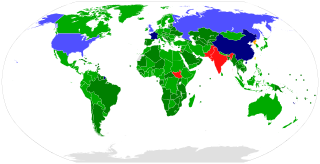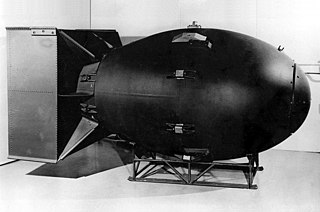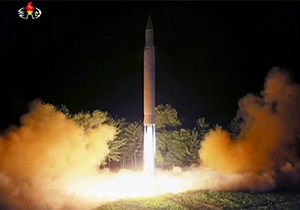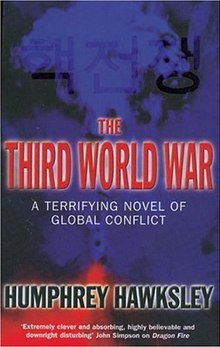
A cruise missile is a guided missile used against terrestrial or naval targets that remains in the atmosphere and flies the major portion of its flight path at approximately constant speed. Cruise missiles are designed to deliver a large warhead over long distances with high precision. Modern cruise missiles are capable of travelling at high subsonic, supersonic, or hypersonic speeds, are self-navigating, and are able to fly on a non-ballistic, extremely low-altitude trajectory.

The Treaty on the Non-Proliferation of Nuclear Weapons, commonly known as the Non-Proliferation Treaty or NPT, is an international treaty whose objective is to prevent the spread of nuclear weapons and weapons technology, to promote cooperation in the peaceful uses of nuclear energy, and to further the goal of achieving nuclear disarmament and general and complete disarmament. Between 1965 and 1968, the treaty was negotiated by the Eighteen Nation Committee on Disarmament, a United Nations-sponsored organization based in Geneva, Switzerland.

Nuclear proliferation is the spread of nuclear weapons, fissionable material, and weapons-applicable nuclear technology and information to nations not recognized as "Nuclear Weapon States" by the Treaty on the Non-Proliferation of Nuclear Weapons, commonly known as the Non-Proliferation Treaty or NPT. Proliferation has been opposed by many nations with and without nuclear weapons, as governments fear that more countries with nuclear weapons will increase the possibility of nuclear warfare, de-stabilize international or regional relations, or infringe upon the national sovereignty of nation states.

Nuclear warfare, also known as atomic warfare, is a theoretical military conflict or prepared political strategy that deploys nuclear weaponry. Nuclear weapons are weapons of mass destruction; in contrast to conventional warfare, nuclear warfare can produce destruction in a much shorter time and can have a long-lasting radiological result. A major nuclear exchange would likely have long-term effects, primarily from the fallout released, and could also lead to secondary effects, such as "nuclear winter", nuclear famine and societal collapse. A global thermonuclear war with Cold War-era stockpiles, or even with the current smaller stockpiles, may lead to various scenarios including the extinction of the human race.

In nuclear strategy, a first strike or preemptive strike is a preemptive surprise attack employing overwhelming force. First strike capability is a country's ability to defeat another nuclear power by destroying its arsenal to the point where the attacking country can survive the weakened retaliation while the opposing side is left unable to continue war. The preferred methodology is to attack the opponent's strategic nuclear weapon facilities, command and control sites, and storage depots first. The strategy is called counterforce.
Mutual assured destruction (MAD) is a doctrine of military strategy and national security policy which posits that a full-scale use of nuclear weapons by an attacker on a nuclear-armed defender with second-strike capabilities would cause the complete annihilation of both the attacker and the defender. It is based on the theory of rational deterrence, which holds that the threat of using strong weapons against the enemy prevents the enemy's use of those same weapons. The strategy is a form of Nash equilibrium in which, once armed, neither side has any incentive to initiate a conflict or to disarm.

In nuclear ethics and deterrence theory, No first use (NFU) refers to a type of pledge or policy wherein a nuclear power formally refrains from the use of nuclear weapons or other weapons of mass destruction (WMDs) in warfare, except for as a second strike in retaliation to an attack by an enemy power using WMDs. Such a pledge would allow for a unique state of affairs in which a given nuclear power can be engaged in a conflict of conventional weaponry while it purposefully foregoes any of the strategic advantages of nuclear weapons, provided the enemy power does not possess or utilize any such weapons of their own. The concept is primarily invoked in reference to nuclear mutually assured destruction but has also been applied to chemical and biological warfare, as is the case of the official WMD policy of India.
Nuclear utilization target selection (NUTS) is a hypothesis regarding the use of nuclear weapons often contrasted with mutually assured destruction (MAD). NUTS theory at its most basic level asserts that it is possible for a limited nuclear exchange to occur and that nuclear weapons are simply one more rung on the ladder of escalation pioneered by Herman Kahn. This leads to a number of other conclusions regarding the potential uses of and responses to nuclear weapons.

World War III or the Third World War, often abbreviated as WWIII or WW3, are names given to a hypothetical worldwide large-scale military conflict subsequent to World War I and World War II. The term has been in use since at least as early as 1941. Some apply it loosely to limited or more minor conflicts such as the Cold War or the war on terror. In contrast, others assume that such a conflict would surpass prior world wars in both scope and destructive impact.

The nuclear arms race was an arms race competition for supremacy in nuclear warfare between the United States, the Soviet Union, and their respective allies during the Cold War. During this same period, in addition to the American and Soviet nuclear stockpiles, other countries developed nuclear weapons, though none engaged in warhead production on nearly the same scale as the two superpowers.

Terminal High Altitude Area Defense (THAAD), formerly Theater High Altitude Area Defense, is an American anti-ballistic missile defense system designed to shoot down short-, medium-, and intermediate-range ballistic missiles in their terminal phase by intercepting with a hit-to-kill approach. THAAD was developed after the experience of Iraq's Scud missile attacks during the Gulf War in 1991. The THAAD interceptor carries no warhead, instead relying on its kinetic energy of impact to destroy the incoming missile.

In nuclear strategy, a retaliatory strike or second-strike capability is a country's assured ability to respond to a nuclear attack with powerful nuclear retaliation against the attacker. To have such an ability is considered vital in nuclear deterrence, as otherwise the other side might attempt to try to win a nuclear war in one massive first strike against its opponent's own nuclear forces.

Two rounds of North Korean missile tests were conducted on July 5, 2006. The Democratic People's Republic of Korea reportedly fired at least seven separate missiles. These included one long-range Taepodong-2 missile and short-range Scud derived missiles including the enlarged Nodong missile. The Taepodong-2 was estimated by United States intelligence agencies as having a potential range reaching as far as Alaska, although this missile failed after about 42 seconds of flight.

A strategic nuclear weapon (SNW) refers to a nuclear weapon that is designed to be used on targets often in settled territory far from the battlefield as part of a strategic plan, such as military bases, military command centers, arms industries, transportation, economic, and energy infrastructure, and heavily populated areas such as cities and towns, which often contain such targets. It is in contrast to a tactical nuclear weapon, which is designed for use in battle as part of an attack with and often near friendly conventional forces, possibly on contested friendly territory.
This timeline of nuclear weapons development is a chronological catalog of the evolution of nuclear weapons rooting from the development of the science surrounding nuclear fission and nuclear fusion. In addition to the scientific advancements, this timeline also includes several political events relating to the development of nuclear weapons. The availability of intelligence on recent advancements in nuclear weapons of several major countries is limited because of the classification of technical knowledge of nuclear weapons development.
Missile defense systems are a type of missile defense intended to shield a country against incoming missiles, such as intercontinental ballistic missiles (ICBMs) or other ballistic missiles. The United States, Russia, India, France, Israel, Italy, United Kingdom, China and Iran have all developed missile defense systems.
The following lists events that happened in 2013 in the Democratic People's Republic of Korea. In 2013, tensions between North Korea and South Korea, the United States, and Japan escalated because of United Nations Security Council Resolution 2087, which condemned North Korea for the launch of Kwangmyŏngsŏng-3 Unit 2. The crisis was marked by increased rhetoric by the new North Korean administration under Kim Jong-un and actions suggesting imminent nuclear attacks against South Korea, Japan, and the United States.

The 2017–18 North Korea crisis was a period of heightened tension between North Korea and the United States throughout 2017. The crisis began early in the year when North Korea conducted a series of missile and nuclear tests that demonstrated the country's ability to launch ballistic missiles beyond its immediate region, suggesting their nuclear weapons capability was developing at a faster rate than had been assessed by U.S. intelligence. Both countries started exchanging increasingly heated rhetoric, including nuclear threats and personal attacks between the two leaders, which, compounded by a joint U.S.–South Korea military exercise undertaken in August and North Korea's sixth nuclear test in September, raised international tensions in the region and beyond and stoked fears about a possible nuclear conflict between the two nations. In addition, North Korea also threatened Australia twice with nuclear strikes throughout the year for their allegiance with the United States.









